shape from shade, so i do not take over Bjorn's |

shape from shade, so i do not take over Bjorn's |
 Apr 7 2010, 04:03 AM Apr 7 2010, 04:03 AM
Post
#1
|
|
|
Member    Group: Members Posts: 890 Joined: 18-November 08 Member No.: 4489 |
So that i do not take over his nice thread i figured i would start a new one
I am just figuring it out so bear with me Rhea This is a example - very early example http://www.shatters.net/forum/viewtopic.php?f=5&t=15847  one that i am going to redo . the program i am using "Cyclops" has a few bugs Enceladus this is a good example a bit better than the above 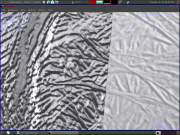 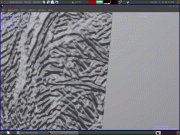 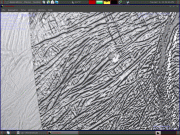 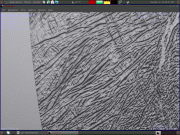 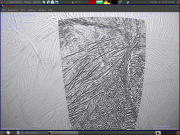 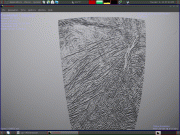 the close ups are a 8k level 3 VT with and without a texture over it then a 4k level2 vt unfortunately i still have to figure out a bug .I need to run a highpass on it ( the 32 bit isis dem ) Cyclops exports to a 3d *.ply this is easy to export to a isis cub and i get this ( this happens when i combine 16 smaller images into one big one ) and this example is at 1/2 size  Just a bit of a bug !!! |
|
|
|
 |
 May 12 2021, 06:47 PM May 12 2021, 06:47 PM
Post
#2
|
|
|
Member    Group: Members Posts: 890 Joined: 18-November 08 Member No.: 4489 |
QUOTE why does the 2 sides of the crater rim SFS dem look higher then everything else this is how the program works the areas that are tangent do not pick up the height data very well this causes the " valley" effect in the direction of the lighting this is one of the drawbacks of using SFS now using gmic to remove most of the low frequency data this is somewhat improved ,but not eliminated there is still no really GREAT solution to this issue SFS is still a problem to be solved |
|
|
|
 May 21 2021, 03:07 AM May 21 2021, 03:07 AM
Post
#3
|
|
 Senior Member     Group: Members Posts: 2530 Joined: 20-April 05 Member No.: 321 |
there is still no really GREAT solution to this issue SFS is still a problem to be solved Indeed. And for a surface with unknown reflectance properties (e.g., an outer solar system body with very few images) not to mention albedo variation that is not due to illumination conditions, it's in principle an unsolvable problem. A 2006 work, for reference: https://ieeexplore.ieee.org/document/1640974 |
|
|
|
 Jun 10 2021, 11:37 AM Jun 10 2021, 11:37 AM
Post
#4
|
|
 Member    Group: Members Posts: 127 Joined: 15-April 21 Member No.: 9009 |
a friend of mine processed this fantastic dem from one of the juno ganymede images
 it captured all the little cracks and stuff very well here is a map verson i made from that dem (fixed inaccurate elevation, and issues in some craters) 
|
|
|
|
 Oct 21 2021, 04:32 PM Oct 21 2021, 04:32 PM
Post
#5
|
|
 Senior Member     Group: Members Posts: 2530 Joined: 20-April 05 Member No.: 321 |
a friend of mine processed this fantastic dem from one of the juno ganymede images [...] it captured all the little cracks and stuff very well This isn't a DEM, and didn't capture Ganymede very well. Ganymede has tremendous variation in albedo and creating a bump map from that (which is a one-minute project in Photoshop) produces something which is largely fiction. Crater rays aren't cracks nor are they elevations, nor do the transitions from darker terrain to grooved terrain translate to regional depressions or elevation. Moreover, the sun angle obviously varies profoundly across the image, with shadows nearly perpendicular at the terminator and almost overhead at the center of the limb. This effort would only be meaningful if the sun angle were approximately constant when it's about as different from constant as imaginable. Projecting this onto a cylindrical map makes it look like Ganymede has one rough area and another smooth area and that is total fiction. There is plenty of data from previous missions that would enable a more complex process that would produce what this aspired to produce, but this isn't it. There are multiple skilled image processing experts who post here and produce amazing, publishable work, but it's not easy, and there's a lot to learn from the care they put into their work. |
|
|
|
 Oct 21 2021, 11:10 PM Oct 21 2021, 11:10 PM
Post
#6
|
||
 Member    Group: Members Posts: 127 Joined: 15-April 21 Member No.: 9009 |
This isn't a DEM, and didn't capture Ganymede very well. Ganymede has tremendous variation in albedo and creating a bump map from that (which is a one-minute project in Photoshop) produces something which is largely fiction. Crater rays aren't cracks nor are they elevations, nor do the transitions from darker terrain to grooved terrain translate to regional depressions or elevation. Moreover, the sun angle obviously varies profoundly across the image, with shadows nearly perpendicular at the terminator and almost overhead at the center of the limb. This effort would only be meaningful if the sun angle were approximately constant when it's about as different from constant as imaginable. Projecting this onto a cylindrical map makes it look like Ganymede has one rough area and another smooth area and that is total fiction. There is plenty of data from previous missions that would enable a more complex process that would produce what this aspired to produce, but this isn't it. There are multiple skilled image processing experts who post here and produce amazing, publishable work, but it's not easy, and there's a lot to learn from the care they put into their work. but than why haven't we seen bigger DEM chunks than really tiny hunks for Ganymede (and Callisto( even fewer for Callisto)) in papers, but for Triton we have most of the cantaloupe terrain (for the approach hemisphere) height mapped, and we have a good chunk of the southern regions height mapped to (all though unreliable), according to this paper, there is plenty of usable PC DEM coverage and stereo DEM coverage (although its not going to be in the best resolution) for callisto there is this blurry DEM from MexLab geoportal (someone turned it into a 3d model and i processed it back into a DEM) but it could be better though does anyone know of any papers with significant stereo or PC DEM coverage that i haven't seen/found yet, because i am clearly missing something. |
|
|
|
||
 Oct 21 2021, 11:24 PM Oct 21 2021, 11:24 PM
Post
#7
|
|
 Senior Member     Group: Members Posts: 2530 Joined: 20-April 05 Member No.: 321 |
but than why haven't we seen bigger DEM chunks than really tiny hunks for Ganymede Possibly nobody finds DEM chunks a really valuable thing to produce. Someone interested in the science of Ganymede's geology can do work like this without trying to publish a map. https://www.sciencedirect.com/science/artic...019103510003945 for callisto there is this blurry DEM from MexLab geoportal Again, this is not a DEM. You seem to think that every bump map generated from albedo is a map of elevation. The bright spots on Callisto are craters with bright subsurface material revealed. Using that brightness to produce a map of elevation is pure fiction. A bump map might happen to be very close to a DEM if a lot of conditions were being met which are not being met in the cases you're playing around with. Eg, fixed albedo, constant illumination geometry, a Lambertian surface or one with minimal specular properties under the given illumination conditions. When those conditions aren't being met, you get a work of fiction. |
|
|
|
 Oct 22 2021, 11:08 AM Oct 22 2021, 11:08 AM
Post
#8
|
|
 Member    Group: Members Posts: 127 Joined: 15-April 21 Member No.: 9009 |
Possibly nobody finds DEM chunks a really valuable thing to produce. Someone interested in the science of Ganymede's geology can do work like this without trying to publish a map. https://www.sciencedirect.com/science/artic...019103510003945 Again, this is not a DEM. You seem to think that every bump map generated from albedo is a map of elevation. The bright spots on Callisto are craters with bright subsurface material revealed. Using that brightness to produce a map of elevation is pure fiction. A bump map might happen to be very close to a DEM if a lot of conditions were being met which are not being met in the cases you're playing around with. Eg, fixed albedo, constant illumination geometry, a Lambertian surface or one with minimal specular properties under the given illumination conditions. When those conditions aren't being met, you get a work of fiction. http://cartsrv.mexlab.ru/geoportal/ thats where the original callisto "dem" came from (you haft to do some playing around to get to it, there is also a blurry europa, and Io "dem") before someone turned it into this model https://www.thingiverse.com/thing:3686246 witch i processed a "dem" from how is DEM data not a viable thing, we need to know topography elevation, like if we wanted to land a probe on an object, we need to know its terrain and as much of its climate as possible? |
|
|
|
 JohnVV shape from shade Apr 7 2010, 04:03 AM
JohnVV shape from shade Apr 7 2010, 04:03 AM
 JohnVV making progress
started with N1500060254_2.img
r... Apr 8 2010, 12:27 AM
JohnVV making progress
started with N1500060254_2.img
r... Apr 8 2010, 12:27 AM
 4th rock from the sun Nice bump maps !
I have already suggested som... Apr 8 2010, 02:53 PM
4th rock from the sun Nice bump maps !
I have already suggested som... Apr 8 2010, 02:53 PM
 JohnVV right now i am working on Dione i have a list of f... Apr 13 2010, 07:26 AM
JohnVV right now i am working on Dione i have a list of f... Apr 13 2010, 07:26 AM
 JohnVV just an update
this is a TESTING only 100% auto t... Apr 17 2010, 03:42 AM
JohnVV just an update
this is a TESTING only 100% auto t... Apr 17 2010, 03:42 AM
 Bjorn Jonsson This looks very impressive, there is some loss of ... Apr 27 2010, 12:41 AM
Bjorn Jonsson This looks very impressive, there is some loss of ... Apr 27 2010, 12:41 AM
 JohnVV hi Bjorn
at this point i am just using a default ... Apr 27 2010, 03:58 AM
JohnVV hi Bjorn
at this point i am just using a default ... Apr 27 2010, 03:58 AM
 JohnVV only 3 show so a link to the photo album
http://w... Apr 27 2010, 04:22 AM
JohnVV only 3 show so a link to the photo album
http://w... Apr 27 2010, 04:22 AM

 Bjorn Jonsson I have now tested Cyclops a bit. The first test ru... Apr 29 2010, 09:26 PM
Bjorn Jonsson I have now tested Cyclops a bit. The first test ru... Apr 29 2010, 09:26 PM

 TrappistPlanets QUOTE (Bjorn Jonsson @ Apr 29 2010, 10:26... Oct 18 2021, 08:48 PM
TrappistPlanets QUOTE (Bjorn Jonsson @ Apr 29 2010, 10:26... Oct 18 2021, 08:48 PM

 JohnVV QUOTE (TrappistPlanets @ Oct 18 2021, 04... Oct 19 2021, 01:22 AM
JohnVV QUOTE (TrappistPlanets @ Oct 18 2021, 04... Oct 19 2021, 01:22 AM

 TrappistPlanets QUOTE (JohnVV @ Oct 19 2021, 02:22 AM) i ... Oct 19 2021, 10:48 AM
TrappistPlanets QUOTE (JohnVV @ Oct 19 2021, 02:22 AM) i ... Oct 19 2021, 10:48 AM
 JohnVV i am calling it a "bug" because i am doi... Apr 30 2010, 02:06 AM
JohnVV i am calling it a "bug" because i am doi... Apr 30 2010, 02:06 AM
 JohnVV while i am starting to put together an ISIS contro... May 3 2010, 04:33 AM
JohnVV while i am starting to put together an ISIS contro... May 3 2010, 04:33 AM

 Bjorn Jonsson QUOTE (JohnVV @ May 3 2010, 04:33 AM) if ... May 4 2010, 02:28 PM
Bjorn Jonsson QUOTE (JohnVV @ May 3 2010, 04:33 AM) if ... May 4 2010, 02:28 PM
 JohnVV at the end will be a link to the folder
newbump.ta... May 6 2010, 06:16 AM
JohnVV at the end will be a link to the folder
newbump.ta... May 6 2010, 06:16 AM
 JohnVV five more and most likely the last until i find wh... May 8 2010, 08:42 PM
JohnVV five more and most likely the last until i find wh... May 8 2010, 08:42 PM

 Bjorn Jonsson Thanks - I'll take a look at these files soon.... May 8 2010, 10:27 PM
Bjorn Jonsson Thanks - I'll take a look at these files soon.... May 8 2010, 10:27 PM

 TrappistPlanets i figured out how to dem process in gimp, but how ... Nov 29 2021, 01:41 AM
TrappistPlanets i figured out how to dem process in gimp, but how ... Nov 29 2021, 01:41 AM

 JohnVV QUOTE (TrappistPlanets @ Nov 28 2021, 08... Nov 29 2021, 03:27 PM
JohnVV QUOTE (TrappistPlanets @ Nov 28 2021, 08... Nov 29 2021, 03:27 PM

 TrappistPlanets QUOTE (JohnVV @ Nov 29 2021, 04:27 PM) i ... Nov 29 2021, 05:24 PM
TrappistPlanets QUOTE (JohnVV @ Nov 29 2021, 04:27 PM) i ... Nov 29 2021, 05:24 PM
 JohnVV first the gimp Gmic filter( was called Graystratio... May 9 2010, 04:02 AM
JohnVV first the gimp Gmic filter( was called Graystratio... May 9 2010, 04:02 AM
 JohnVV a bit of a change - the below will create a ... May 13 2010, 06:42 PM
JohnVV a bit of a change - the below will create a ... May 13 2010, 06:42 PM
 JohnVV 2)
removing the curvature
yes one or two meshes c... May 13 2010, 08:01 PM
JohnVV 2)
removing the curvature
yes one or two meshes c... May 13 2010, 08:01 PM
 Sajid Interesting work you are doing.
Where did you fi... May 13 2010, 08:20 PM
Sajid Interesting work you are doing.
Where did you fi... May 13 2010, 08:20 PM
 JohnVV 3)
convert the hipassed normal to a mesh then to ... May 13 2010, 08:39 PM
JohnVV 3)
convert the hipassed normal to a mesh then to ... May 13 2010, 08:39 PM
 JohnVV 4)
-- optional --
i like to normalize and convert ... May 13 2010, 11:46 PM
JohnVV 4)
-- optional --
i like to normalize and convert ... May 13 2010, 11:46 PM
 JohnVV an update
just a "testing " shot
with... May 28 2010, 12:07 AM
JohnVV an update
just a "testing " shot
with... May 28 2010, 12:07 AM
 Bjorn Jonsson Looks very promising despite the 'terraced... Jun 6 2010, 09:05 PM
Bjorn Jonsson Looks very promising despite the 'terraced... Jun 6 2010, 09:05 PM
 JohnVV QUOTE Looks very promising despite the 'terrac... Jun 7 2010, 03:02 AM
JohnVV QUOTE Looks very promising despite the 'terrac... Jun 7 2010, 03:02 AM
 4th rock from the sun I've programed a simple SFS implementation in ... Sep 2 2010, 01:16 PM
4th rock from the sun I've programed a simple SFS implementation in ... Sep 2 2010, 01:16 PM

 AndyG Very nice!
ActionScript, huh? Smarty-pants... Sep 2 2010, 01:52 PM
AndyG Very nice!
ActionScript, huh? Smarty-pants... Sep 2 2010, 01:52 PM

 4th rock from the sun Thanks!
I'm reading the image as a raste... Sep 2 2010, 10:17 PM
4th rock from the sun Thanks!
I'm reading the image as a raste... Sep 2 2010, 10:17 PM
 JohnVV the main problem has been with non optimal images ... Sep 2 2010, 11:24 PM
JohnVV the main problem has been with non optimal images ... Sep 2 2010, 11:24 PM
 JohnVV just a bit of an update
stereo is by far better ... Feb 1 2012, 05:04 AM
JohnVV just a bit of an update
stereo is by far better ... Feb 1 2012, 05:04 AM

 volcanopele QUOTE (JohnVV @ Jan 31 2012, 10:04 PM) th... Feb 1 2012, 06:11 AM
volcanopele QUOTE (JohnVV @ Jan 31 2012, 10:04 PM) th... Feb 1 2012, 06:11 AM
 JohnVV a height map but that spot IS an artifact from Sh... Feb 1 2012, 06:53 AM
JohnVV a height map but that spot IS an artifact from Sh... Feb 1 2012, 06:53 AM
 JohnVV for now i have dropped the hyperionCV sfs in favor... Apr 17 2012, 09:03 AM
JohnVV for now i have dropped the hyperionCV sfs in favor... Apr 17 2012, 09:03 AM

 TrappistPlanets QUOTE (JohnVV @ Apr 17 2012, 10:03 AM) fo... May 10 2021, 12:52 PM
TrappistPlanets QUOTE (JohnVV @ Apr 17 2012, 10:03 AM) fo... May 10 2021, 12:52 PM
 JohnVV just a update on a rather old thread
i was asked ... Jan 15 2018, 06:13 AM
JohnVV just a update on a rather old thread
i was asked ... Jan 15 2018, 06:13 AM
 TrappistPlanets i have a SFS dem of umbriel May 10 2021, 01:05 PM
TrappistPlanets i have a SFS dem of umbriel May 10 2021, 01:05 PM
 TrappistPlanets sorry that the attachemt was spammed, my computer ... May 10 2021, 01:07 PM
TrappistPlanets sorry that the attachemt was spammed, my computer ... May 10 2021, 01:07 PM

 TrappistPlanets QUOTE (JohnVV @ May 12 2021, 06:47 PM) th... May 12 2021, 11:25 PM
TrappistPlanets QUOTE (JohnVV @ May 12 2021, 06:47 PM) th... May 12 2021, 11:25 PM

 JRehling First of all, the standard of citing research is t... Oct 22 2021, 02:31 PM
JRehling First of all, the standard of citing research is t... Oct 22 2021, 02:31 PM
 JohnVV QUOTE i don't know how to compile programs vea... Oct 19 2021, 02:29 PM
JohnVV QUOTE i don't know how to compile programs vea... Oct 19 2021, 02:29 PM
 stevesliva Just FYI... There was this other discussion: http:... Oct 22 2021, 04:47 PM
stevesliva Just FYI... There was this other discussion: http:... Oct 22 2021, 04:47 PM

 TrappistPlanets QUOTE (stevesliva @ Oct 22 2021, 04:47 PM... Oct 23 2021, 11:53 AM
TrappistPlanets QUOTE (stevesliva @ Oct 22 2021, 04:47 PM... Oct 23 2021, 11:53 AM
 Phil Stooke Schenk, P., McKinnon, W.B., Moore, J. and Nimmo, F... Oct 23 2021, 07:00 PM
Phil Stooke Schenk, P., McKinnon, W.B., Moore, J. and Nimmo, F... Oct 23 2021, 07:00 PM

 TrappistPlanets QUOTE (Phil Stooke @ Oct 23 2021, 07:00 P... Oct 23 2021, 10:48 PM
TrappistPlanets QUOTE (Phil Stooke @ Oct 23 2021, 07:00 P... Oct 23 2021, 10:48 PM

 JRehling QUOTE (TrappistPlanets @ Oct 23 2021, 03... Oct 23 2021, 11:26 PM
JRehling QUOTE (TrappistPlanets @ Oct 23 2021, 03... Oct 23 2021, 11:26 PM

 JRehling Here's the full text of a paper explaining the... Oct 24 2021, 07:00 PM
JRehling Here's the full text of a paper explaining the... Oct 24 2021, 07:00 PM
 JohnVV a google search found the MS windows binaries
htt... Nov 29 2021, 05:41 PM
JohnVV a google search found the MS windows binaries
htt... Nov 29 2021, 05:41 PM
 TrappistPlanets QUOTE (JohnVV @ Nov 29 2021, 06:41 PM) a ... Nov 29 2021, 05:58 PM
TrappistPlanets QUOTE (JohnVV @ Nov 29 2021, 06:41 PM) a ... Nov 29 2021, 05:58 PM  |

|
Lo-Fi Version | Time is now: 10th November 2024 - 06:05 PM |
|
RULES AND GUIDELINES Please read the Forum Rules and Guidelines before posting. IMAGE COPYRIGHT |
OPINIONS AND MODERATION Opinions expressed on UnmannedSpaceflight.com are those of the individual posters and do not necessarily reflect the opinions of UnmannedSpaceflight.com or The Planetary Society. The all-volunteer UnmannedSpaceflight.com moderation team is wholly independent of The Planetary Society. The Planetary Society has no influence over decisions made by the UnmannedSpaceflight.com moderators. |
SUPPORT THE FORUM Unmannedspaceflight.com is funded by the Planetary Society. Please consider supporting our work and many other projects by donating to the Society or becoming a member. |

|